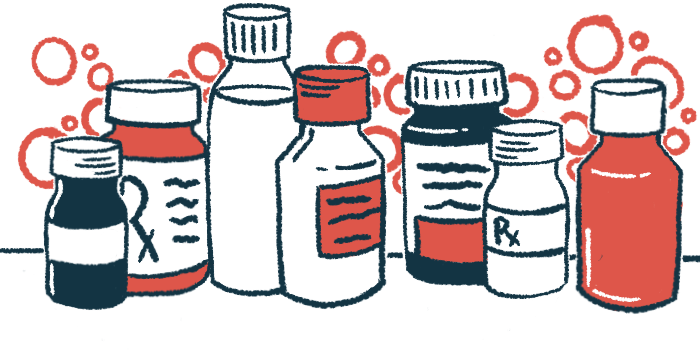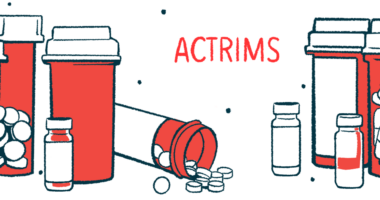ECTRIMS 2023: Most on Zeposia see slower disability progression
Fewer PIRA events observed than typical in MS patients, trial data show

More than three-quarters of people with relapsing forms of multiple sclerosis (MS) who received Zeposia (ozanimod) in the RADIANCE clinical trial and its extension study still haven’t experienced confirmed disability progression after eight years of follow-up, new data shows.
Among those who progressed, about half of disability progression events were associated with relapses, also called relapse-associated worsening (RAW), and the other half was progression independent of relapse activity (PIRA).
However, the number of PIRA events was lower than what’s commonly observed in MS patients, researchers noted.
“Even in the absence of relapses, people living with multiple sclerosis may have smoldering neuroinflammation … and continuous disease activity occurring simultaneously in different areas of the brain,” Jeffrey Cohen, MD, a neurologist at the Cleveland Clinic’s Mellen Center for Multiple Sclerosis Treatment and Research, said in a Bristol Myers Squibb press release.
“Given literature has shown that 25% of people living with multiple sclerosis develop PIRA after approximately seven years, these new analyses are relevant for doctors and patients as they consider early intervention with highly effective therapies to hinder smoldering disease … and relapses,” added Cohen, a paid consultant of Bristol Myers Squibb, the company that markets Zeposia.
The findings were presented at the 9th joint meeting of the European Committee for Treatment and Research in Multiple Sclerosis (ECTRIMS) and the Americas Committee for Treatment and Research in Multiple Sclerosis (ACTRIMS), held last week in Milan and online.
The poster was titled, “Relapse-Associated Worsening and Progression-Independent Relapse Activity in Ozanimod-Treated Participants With Relapsing Multiple Sclerosis From the RADIANCE and DAYBREAK Trials,” and the work was supported by Bristol Myers.
Traditionally, MS has been divided in two general classifications based on how patients’ disability progressed. In people with relapsing types of MS, disability was believed to accrue after incomplete recovery from relapses, while progression occurred independent of relapses in people with progressive forms of MS.
However, recent research has shown that people with relapsing forms of MS also experience an increase in their disability even when they have not experienced relapses for a long time.
In fact, it now is known that most disability progression events across all forms of MS occur in the absence of relapses, especially when patients are receiving treatments that effectively prevent relapses.
RADIANCE, DAYBREAK clinical trials
In the RADIANCE Phase 3 clinical trial (NCT02047734) and its extension study DAYBREAK (NCT02576717), Zeposia provided sustained control of disability progression for up to five years. However, the treatment’s effects on rates of PIRA and RAW have not been described.
RADIANCE was a two-year study that compared Zeposia, an MS treatment that works to prevent immune cells from getting into the brain and spinal cord, with the older approved interferon-based therapy Avonex (interferon beta-1a).
More than 1,300 patients with relapsing forms of MS, including relapsing-remitting MS (RRMS) and active secondary progressive MS (SPMS), were enrolled in the study. Those who completed the two-year study then were eligible to enter the DAYBREAK extension, where all are receiving Zeposia for up to seven years.
In the ECTRIMS-ACTRIMS poster, researchers reported the proportion of patients who experienced either PIRA or RAW after up to eight years of follow-up — two years in the main trial and seven in the extension study.
The analyses included 363 participants who received continuous Zeposia during the follow-up, and 346 who switched from Avonex to Zeposia in the open-label extension.
Confirmed disability progression (CDP), defined as an increase in Expanded Disability Status Scale (EDSS) scores that are confirmed in a follow-up assessment at least six months later, was observed in about 24% of participants over the eight years.
In total, more than three-quarters of patients who were either always on Zeposia (75.8%) or who received the treatment two years later (76%) had not experienced CPD at their last follow-up.
PIRA and RAW rates
In the entire population, rates of PIRA and RAW were fairly similar, each contributing to about half of the total progression events.
But patients who started on Zeposia in the main trial had lower rates of RAW (10.7% vs. 13.9%) and higher PIRA rates (13.2% vs. 10.4%) than the late starters. These differences potentially are due to Zeposia’s greater efficacy than Avonex at lowering relapse rates, thereby also being better at reducing progression associated with relapses.
The researchers also conducted an analysis where they accounted only for disability progression events happening in the DAYBREAK extension, when all were already receiving Zeposia.
Data showed that more patients who were on Avonex previously experienced confirmed disability progression (17.9% vs. 14%). These patients started to see a reduction in their RAW events in the extension part, but the greatest reductions in RAW continued to be observed in the group that was always on Zeposia.
In both groups of patients, factors that could predict RAW significantly included higher EDSS scores at the start of RADIANCE, and lower volume of the brain and of certain brain regions affected in MS.
Overall, the findings show that, in patients treated with Zeposia, “RAW and PIRA contributed similarly to disability progression over 8 [years]” the researchers concluded.
Note: The Multiple Sclerosis News Today team is providing in-depth coverage of the 9th joint ECTRIMS-ACTRIMS meeting Oct. 11-13. Go here to see the latest stories from the conference.







